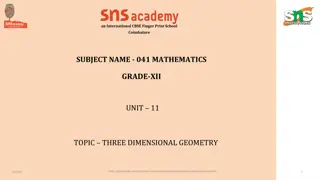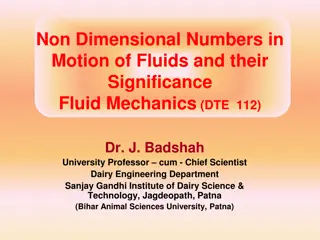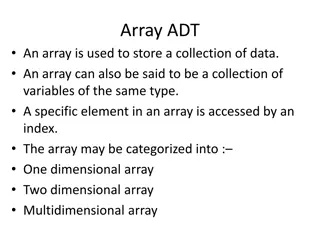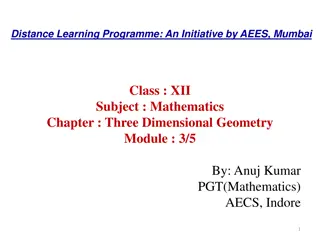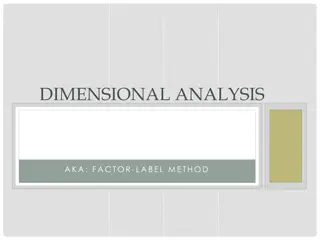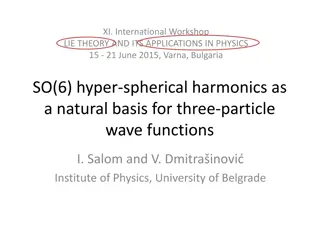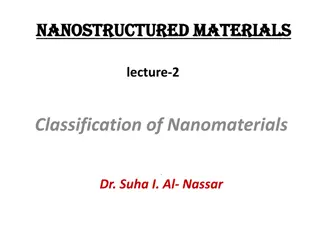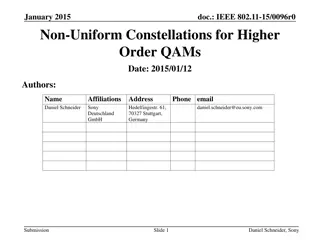
Dimensional Analysis and its Applications in Engineering Problems
Learn about the significance of Dimensional Analysis, how it helps in predicting mechanisms, reducing equations, and transforming units. Explore the steps involved in applying Dimensional Analysis to mathematically represent engineering problems effectively.
Download Presentation

Please find below an Image/Link to download the presentation.
The content on the website is provided AS IS for your information and personal use only. It may not be sold, licensed, or shared on other websites without obtaining consent from the author. If you encounter any issues during the download, it is possible that the publisher has removed the file from their server.
You are allowed to download the files provided on this website for personal or commercial use, subject to the condition that they are used lawfully. All files are the property of their respective owners.
The content on the website is provided AS IS for your information and personal use only. It may not be sold, licensed, or shared on other websites without obtaining consent from the author.
E N D
Presentation Transcript
Dimensional Analysis and Its Applications Dr. J. Badshah University Professor cum - Chief Scientist Dairy Engineering Department Sanjay Gandhi Institute of Dairy Science & Technology, Jagdeopath, Patna (Bihar Animal Sciences University, Patna)
Dimensional Analysis Dimensional Analysis is a process of arranging various factors in a manner that it forms dimensionless number. Its principal use is to deduce the expression of dependent variable in terms of independent variables in a study. An equation will be dimensionally homogeneous if the dimensions of various terms on the two sides of the equation are identical. A dimensionally homogeneous equation is independent of the fundamental units of measurement and is applicable to all systems of units. T = 2 l/g, Dimension on LHS and RHS same as [T] shows homogeneity of equation. Utilized in developing of models to predict the mechanisms and economize the resources (6 Ms) requirements. Utilized for hydraulic similitude of Prototype and model of physical structure, equipments, Machines and products for safe and efficient design.
Application of Dimensional Analysis Application of Dimensional Analysis To determine the dimensional homogeneity of any equation which helps to determine the dimensions and thus the units of any quantity. Units can be easily transformed from one system to another. To establish relationship between number of variables. To reduce equations by arranging variables in dimensionless forms. The application of dimensional analysis to mathematically represent engineering problems consists of several steps. Steps for Dimensional Analysis Formulate a differential equations and/or algebraic expressions which adequately describe the problem, together with the required boundary conditions; Select the appropriate dimensionless variables tor all independent and dependent variables involved, using arbitrary terms or boundary values for the denominator in each case;
Steps for Dimensional Analysis Substitute the new dimensionless variables into each differential equation and boundary condition to normalize them; Group into functional form all dimensionless variables and those parameters generated; Reduce the functionality to the minimum possible number of independent groups; and Drop any groups in which the arbitrary terms can not be divided out using other groups of the functionality.
Rayleighs Method for Dimensional Analysis Independent functional relationship most closely. A maximum of three to four variables must be selected. variables are identified which will express the If the dependent variable X is some function of the independent variables x1, x2, x3 ., The equation is written as: X = f (x1, x2, x3 ) Above equation may be written as: X = C(x1a, x2 be determined through experiments Values of a, b, c etc are determined by comparing the powers on both sides. b, x3 c, ), where C is a dimensionless coefficient to
Buckinghams - method of Dimensional Analysis It states that if there are n variables in a dimensionally homogeneous equation and if fundamental (primary) dimensions then the variables can be grouped into (n - m) dimensionless terms. These dimensionless terms are called Terms. We use M L T fundamental quantities in fluid mechanics. Mathematically if x1 depends on other variables x2, x3, x4...xn the equation can be given as x1 = f ( x2, x3, x4 , xn) f(x1, x2, x3, x4 , xn) = 0 Where x are dimensional physical quantities such as velocity, density, pressure, area, diameter etc. Then the phenomenon given in equation (i) can be described by (n-m) dimensionless terms. f ( 1, 2, . n-m) = 0 where m represents the fundamental dimensions such as mass, length and time. these variables contain m (i)
Numerical The resistance R experienced by a partially submerged body depends upon the velocity V, length of the body l, viscosity of the fluid , density of the fluid and gravitational acceleration g. Obtain a dimensionless express for resistance R. Solution: Mathematically following relation can be given: R = f (V, l, , , g) f (R,V, l, , , g) = 0 No. of variables n = 6 and No. of fundamental variable m =3 Therefore No. of terms = 6 -3 =3 Terms Choose length l, velocity V and density are three repeating variables. Analysis of - terms 1= (la1, Vb1, c1, R) [M0L0T0] =[L]a1 [Lt-1]b1[ml-3]c1[MLT-2] 2= (la2, Vb2, c2, ) [M0L0T0]= [L]a2 [Lt-1]b2[ml-3]c2[ML-1T-1] 3= (la3, Vb3, c3, g) [M0L0T0] = [L]a3 [Lt-1]b3[ml-3]c3[LT-2]
Numerical On solution of equations: 1= R/ l2v2 2= /l V 3= l g/ V2 The functional relationship can be given as: = f [ 1, 2, 3] = 0 = f [R/ l2v2 , /l V , l g/ V2] = 0 R/ l2v2 = ( /l V , l g/ V2) R/ l2v2 = ( l V / , V/ l g) (Since reciprocal of -term and its square root is non-dimensional) R = l2v2 ( l V / , V/ l g) R = l2v2 ( NRe, NFr) where Nre: Reynolds Number & NFr: Froud Number. It is evident that resistance R is a function of Reynolds number and Froude s number.
Numerical Derive a general functional relationship of a flow phenomenon which depends upoconstantn the following variables f[ , , g, K, p, V, , l, D] = constant Solution: N=9 and m= 3, Therefore No. of -terms = m-n=9-3=6 Taking , l , v as repeating variables and on solving the equation by homogeneity principle 1=(la1, Vb1, c1, ) = l V / = NRe= Reynolds Number 2= (la2, Vb2, c2, g) = V/ l g = NFr= Froud Number 3= (la3, Vb3, c3, k) = V/ K/ = NM= Mach No. 4= (la4, Vb4, c4, p) = V/ p/ = NE= Euler No. 5= (la5, Vb5, c5, ) = V/ / l = NWb=Weber No. 6= (la6, Vb6, c6, D) =D/l Therefore general relationship can be written as: f (NRe, NF, NM, NE, NWb, D/L) = Constant

